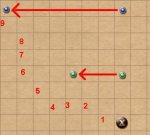UngeheuerLich
Legend
Ask a football trainer what he thinks about this kind of defense...
That the fighter really is not on a good square to protect his wizard. He should be either one square nearer to the attacker or 2 squares nearer to wizard.*
But i also expect the fighter to have an ability to shift when its not his turn. And this fits with my imagination of trained and untrained defenders.
Also there could be a rule, that you pay 1 extra mp if you don´t move in a straight line/turn 90°. That would usually be enough to solve most problems with running in circles to avoid opportunity attacks.
*(and actually, there IS a problem that if he would stand 2 squares nearer to the wizard he would still not get an opportunity attack)
That the fighter really is not on a good square to protect his wizard. He should be either one square nearer to the attacker or 2 squares nearer to wizard.*
But i also expect the fighter to have an ability to shift when its not his turn. And this fits with my imagination of trained and untrained defenders.
Also there could be a rule, that you pay 1 extra mp if you don´t move in a straight line/turn 90°. That would usually be enough to solve most problems with running in circles to avoid opportunity attacks.
*(and actually, there IS a problem that if he would stand 2 squares nearer to the wizard he would still not get an opportunity attack)




